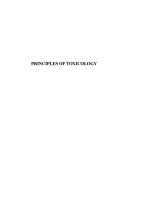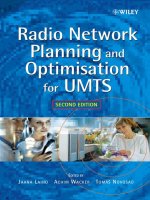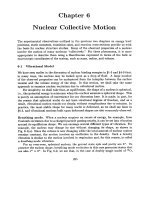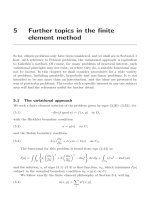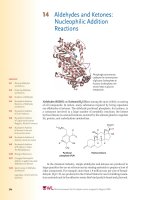- Trang chủ >>
- Khoa Học Tự Nhiên >>
- Vật lý
Ebook Physical chemistry for the life sciences (2nd edition) Part 1
Bạn đang xem bản rút gọn của tài liệu. Xem và tải ngay bản đầy đủ của tài liệu tại đây (17.96 MB, 338 trang )
This page intentionally left blank
Physical Chemistry for the Life Sciences
Library of Congress Number: 2010940703
© 2006, 2011 by P.W. Atkins and J. de Paula
All rights reserved.
Printed in Italy by L.E.G.O. S.p.A
First printing
Published in the United States and Canada by
W. H. Freeman and Company
41 Madison Avenue
New York, NY 10010
www.whfreeman.com
ISBN-13: 978-1-4292-3114-5
ISBN-10: 1-4292-3114-9
Published in the rest of the world by
Oxford University Press
Great Clarendon Street
Oxford OX2 6DP
United Kingdom
www.oup.com
ISBN: 978-0-19-956428-6
Physical Chemistry
for the Life Sciences
Second edition
Peter Atkins
Professor of Chemistry, Oxford University
Julio de Paula
Professor of Chemistry, Lewis & Clark College
W. H. Freeman and Company
New York
This page intentionally left blank
Contents in brief
Prolog
Fundamentals
xxi
1
PART 1 Biochemical thermodynamics
21
1
2
3
4
5
The First Law
The Second Law
Phase equilibria
Chemical equilibrium
Thermodynamics of ion and electron transport
23
69
94
135
181
PART 2 The kinetics of life processes
217
6 The rates of reactions
7 Accounting for the rate laws
8 Complex biochemical processes
219
243
273
PART 3 Biomolecular structure
9 Microscopic systems and quantization
10 The chemical bond
11 Macromolecules and self-assembly
PART 4 Biochemical spectroscopy
12 Optical spectroscopy and photobiology
13 Magnetic resonance
311
313
364
407
461
463
514
Resource section
1 Atlas of structures
2 Units
3 Data
546
558
560
Answers to odd-numbered exercises
Index of Tables
Index
573
577
579
This page intentionally left blank
Full contents
Prolog
xxi
The structure of physical chemistry
xxi
(a)
The organization of science
xxi
(b)
The organization of our presentation
xxii
Applications of physical chemistry to biology and medicine
(a)
Techniques for the study of biological systems
xxii
1.4
The measurement of heat
32
(a) Heat capacity
33
(b) The molecular interpretation of heat capacity
34
Internal energy and enthalpy
1.5
The internal energy
(a) Changes in internal energy
xxii
34
35
35
(b) Protein folding
xxiii
Example 1.1 Calculating the change in internal energy
(c)
Rational drug design
xxv
(b) The internal energy as a state function
37
(d)
Biological energy conversion
xxv
(c) The First Law of thermodynamics
38
1.6 The enthalpy
36
38
Fundamentals
1
(a) The definition of enthalpy
39
F.1 Atoms, ions, and molecules
1
(b) Changes in enthalpy
39
(c) The temperature dependence of the enthalpy
41
(a)
Bonding and nonbonding interactions
1
(b)
Structural and functional units
2
(c)
Levels of structure
3
F.2 Bulk matter
(a)
States of matter
4
5
(c)
8
F.3 Energy
(a)
Varieties of energy
(b)
The Boltzmann distribution
Checklist of key concepts
Checklist of key equations
Discussion questions
Exercises
Projects
(a) Bomb calorimeters
4
(b) Physical state
Equations of state
In the laboratory 1.1 Calorimetry
Example 1.2 Calibrating a calorimeter and measuring
the energy content of a nutrient
(b) Isobaric calorimeters
(c) Differential scanning calorimeters
10
11
13
17
17
18
18
19
Physical and chemical change
1.7
21
1 The First Law
23
The conservation of energy
23
1.1
Systems and surroundings
24
1.2
Work and heat
25
44
46
46
46
Thermochemical properties of fuels
The combination of reaction enthalpies
Example 1.4 Using Hess’s law
Standard enthalpies of formation
Example 1.5 Using standard enthalpies of formation
49
51
52
55
57
58
58
59
25
1.12
Enthalpies of formation and computational chemistry
61
(b) The molecular interpretation of work and heat
26
1.13
The variation of reaction enthalpy with temperature
62
(c) The molecular interpretation of temperature
26
(a) Exothermic and endothermic processes
Case study 1.1 Energy conversion in organisms
1.3
44
47
Case study 1.2 Biological fuels
1.11
43
(b) Enthalpies of vaporization, fusion, and sublimation
Example 1.3 Using mean bond enthalpies
1.10
42
(a) Phase transitions
1.8 Bond enthalpy
1.9
PART 1 Biochemical thermodynamics
Enthalpy changes accompanying physical processes
42
27
The measurement of work
29
(a) Sign conventions
29
(b) Expansion work
30
(c) Maximum work
31
Example 1.6 Using Kirchhoff’s law
63
Checklist of key concepts
Checklist of key equations
Discussion questions
Exercises
Projects
64
65
65
65
68
viii
FULL CONTENTS
2 The Second Law
69
Entropy
70
2.1
The direction of spontaneous change
70
2.2
Entropy and the Second Law
71
(a) The definition of entropy
71
2.3
2.5
112
(c) The chemical potential of a solute
114
Example 3.2 Determining whether a natural water can
support aquatic life
116
Case study 3.2 Gas solubility and breathing
117
73
(c) The entropy change accompanying a phase transition
75
(d) Real solutions: activities
118
(d) Entropy changes in the surroundings
77
Case study 3.3 The Donnan equilibrium
119
Absolute entropies and the Third Law of thermodynamics
77
Example 3.3 Analyzing a Donnan equilibrium
121
78
The molecular interpretation of the Second and Third Laws
80
(a) The Boltzmann formula
80
(b) The relation between thermodynamic and
statistical entropy
81
(c) The residual entropy
82
Entropy changes accompanying chemical reactions
82
(a) Standard reaction entropies
82
(b) The spontaneity of chemical reactions
83
The Gibbs energy
2.6
112
(b) The chemical potential of a solvent
(b) The entropy change accompanying heating
In the laboratory 2.1 The measurement of entropies
2.4
(a) The chemical potential of a gas
84
Focusing on the system
84
(a) The definition of the Gibbs energy
84
(b) Spontaneity and the Gibbs energy
Case study 2.1 Life and the Second Law
85
85
(e) The thermodynamics of dissolving
Colligative properties
3.9
The modification of boiling and freezing points
3.10 Osmosis
121
122
123
125
In the laboratory 3.1 Osmometry
127
Example 3.4 Determining the molar mass of an enzyme from
measurements of the osmotic pressure
127
Checklist of key concepts
Checklist of key equations
Further information 3.1 The phase rule
Further information 3.2 Measures of concentration
128
129
129
130
Example 3.5 Relating mole fraction and molality
131
132
132
134
2.7
The hydrophobic interaction
86
2.8
Work and the Gibbs energy change
88
Discussion questions
Exercises
Projects
Example 2.1 Estimating a change in Gibbs energy for
a metabolic process
89
4 Chemical equilibrium
135
Case study 2.2 The action of adenosine triphosphate
90
Thermodynamic background
135
Checklist of key concepts
Checklist of key equations
Discussion questions
Exercises
Projects
90
91
91
91
92
3 Phase equilibria
94
The thermodynamics of transition
94
4.1
The reaction Gibbs energy
135
4.2
The variation of ΔrG with composition
137
(a) The reaction quotient
137
Example 4.1 Formulating a reaction quotient
(b) Biological standard states
Example 4.2 Converting between thermodynamic and
biological standard states
4.3
142
94
(a) The significance of the equilibrium constant
3.2
The variation of Gibbs energy with pressure
95
(b) The composition at equilibrium
3.3
The variation of Gibbs energy with temperature
98
(b) The location of phase boundaries
101
(c) Characteristic points
103
(d) The phase diagram of water
105
Phase transitions in biopolymers and aggregates
3.5
The stability of nucleic acids and proteins
Example 3.1 Predicting the melting temperature of DNA
3.6
99
100
Phase transitions of biological membranes
Case study 3.1 The use of phase diagrams in the study
of proteins
The thermodynamic description of mixtures
106
106
140
140
The condition of stability
(a) Phase boundaries
139
Reactions at equilibrium
3.1
3.4 Phase diagrams
138
143
Example 4.3 Calculating an equilibrium composition
143
(c) The molecular origin of chemical equilibrium
144
Case study 4.1 Binding of oxygen to myoglobin and
hemoglobin
144
4.4
The standard reaction Gibbs energy
Example 4.4 Calculating the standard reaction Gibbs energy
of an enzyme-catalyzed reaction
146
146
107
(a) Standard Gibbs energies of formation
147
108
(b) Stability and instability
149
The response of equilibria to the conditions
109
4.5
The presence of a catalyst
4.6
The effect of temperature
149
150
150
110
3.7
The chemical potential
110
3.8
Ideal and ideal–dilute solutions
111
Coupled reactions in bioenergetics
151
Case study 4.2 ATP and the biosynthesis of proteins
152
FULL CONTENTS
Case study 4.3 The oxidation of glucose
153
Proton transfer equilibria
156
ix
Example 5.4 Converting a standard potential to a biological
standard value
200
4.7 Brønsted–Lowry theory
156
In the laboratory 5.1 Ion-selective electrodes
201
4.8
Protonation and deprotonation
157
Applications of standard potentials
202
(a) The strengths of acids and bases
158
(b) The pH of a solution of a weak acid
161
Example 4.5 Estimating the pH of a solution of a weak acid
(c) The pH of a solution of a weak base
161
163
Example 4.6 Estimating the pH of a solution of a weak base
163
(d) The extent of protonation and deprotonation
163
(e) The pH of solutions of salts
164
4.9 Polyprotic acids
165
Case study 4.4 The fractional composition of a solution
of lysine
166
(a) The fractional composition of amino acid solutions
(b) The pH of solutions of amphiprotic anions
4.11 Buffer solutions
170
172
Case study 4.5 Buffer action in blood
173
Checklist of key concepts
Checklist of key equations
Further information 4.1 The contribution of autoprotolysis to pH
Further information 4.2 The pH of an amphiprotic salt solution
Discussion questions
Exercises
Projects
174
175
175
176
177
177
180
5 Thermodynamics of ion and electron transport
181
Transport of ions across biological membranes
181
5.1
5.2
205
(c) Calculation of the standard reaction entropy
and enthalpy
206
The electrochemical series
207
Electron transfer in bioenergetics
207
5.9
5.10
The respiratory chain
207
(a) Electron transfer reactions
208
(b) Oxidative phosphorylation
208
5.11 Plant photosynthesis
Checklist of key concepts
Checklist of key equations
Discussion questions
Exercises
Project
209
211
212
212
212
215
PART 2 The kinetics of life processes
217
6 The rates of reactions
219
Reaction rates
219
In the laboratory 6.1 Experimental techniques
219
(a) The determination of concentration
219
(b) Monitoring the time dependence
220
6.1
The definition of reaction rate
221
(a) Activity coefficients
182
6.2
Rate laws and rate constants
223
(b) Debye–Hückel theory
184
Passive and active transport of ions across biological
membranes
Ion channels and ion pumps
Redox reactions
5.4 Half-reactions
224
The determination of the rate law
225
(a) Isolation and pseudo-order reactions
225
(b) The method of initial rates
226
187
188
188
Example 6.1 Using the method of initial rates
6.5
Integrated rate laws
227
228
189
(a) Zeroth-order reactions
228
190
(b) First-order reactions
228
(c) Second-order reactions
231
190
Example 5.3 Writing the reaction quotient for a half-reaction
191
Reactions in electrochemical cells
192
(a) Galvanic and electrolytic cells
192
(b) Varieties of electrodes
194
(c) Electrochemical cell notation
194
The Nernst equation
195
5.7 Standard potentials
6.3 Reaction order
6.4
186
Example 5.2 Expressing a reaction in terms of half-reactions
5.6
205
181
Case study 5.1 Action potentials
5.5
204
Ions in solution
Example 5.1 Estimating a membrane potential
5.3
203
Example 5.6 Calculating a standard potential
from two other standard potentials
169
Example 4.8 Assessing buffer action
202
(a) Calculation of the equilibrium constant
(b) Calculation of standard potentials
169
169
The determination of thermodynamic functions
Example 5.5 Calculating the equilibrium constant of
a biological electron transfer reaction
164
Example 4.7 Calculating the concentration of carbonate
ion in carbonic acid
4.10 Amphiprotic systems
5.8
197
(a) Thermodynamic standard potentials
198
(b) Variation of potential with pH
198
(c) The biological standard potential
200
Case study 6.1 Pharmacokinetics
234
The temperature dependence of reaction rates
235
6.6
The Arrhenius equation
Example 6.2 Determining the Arrhenius parameters
6.7
Preliminary interpretation of the Arrhenius parameters
Checklist of key concepts
Checklist of key equations
Discussion questions
Exercises
Project
235
236
237
239
239
239
240
242
x
FULL CONTENTS
7 Accounting for the rate laws
Reaction mechanisms
7.1
243
243
Example 8.3 The isoelectric point of a protein
8.8
293
Transport across ion channels and ion pumps
294
(a) The potassium channel
294
The approach to equilibrium
243
(a) The relation between equilibrium constants and
rate constants
243
(b) The time-dependence of the approach to equilibrium
245
8.9
The rates of electron transfer processes
245
8.10
The theory of electron transfer processes
298
8.11
Experimental tests of the theory
299
8.12
The Marcus cross-relation
300
In the laboratory 7.1 Relaxation techniques in biochemistry
7.2 Elementary reactions
247
7.3 Consecutive reactions
249
(b) The proton pump
Electron transfer in biological systems
295
296
296
(a) The variation of concentration with time
249
Example 8.4 Using the Marcus cross-relation
302
(b) The rate-determining step
251
Checklist of key concepts
Checklist of key equations
Further information 8.1 Fick’s laws of diffusion
303
303
304
1. Fick’s first law of diffusion
304
Example 7.1 Identifying a rate-determining step
252
(c) The steady-state approximation
252
(d) Pre-equilibria
253
Case study 7.1 Mechanisms of protein folding and unfolding
254
7.4 Diffusion control
256
7.5
258
Kinetic and thermodynamic control
Reaction dynamics
304
Discussion questions
Exercises
Projects
305
305
308
259
7.6 Collision theory
259
7.7
Transition state theory
261
(a) Formulation of the theory
261
(b) Thermodynamic parameterization
262
In the laboratory 7.2 Time-resolved spectroscopy for kinetics
2. Fick’s second law
263
PART 3 Biomolecular structure
311
9 Microscopic systems and quantization
313
Principles of quantum theory
313
The emergence of the quantum theory
314
264
(a) Atomic and molecular spectra
314
Example 7.2 Analyzing the kinetic salt effect
266
(b) Wave–particle duality
315
Checklist of key concepts
Checklist of key equations
Further information 7.1 Collisions in the gas phase
267
267
267
7.8
The kinetic salt effect
(a) The kinetic model of gases
267
(b) The Maxwell distribution of speeds
268
(c) Molecular collisions
9.1
Example 9.1 Estimating the de Broglie wavelength of electrons
316
In the laboratory 9.1 Electron microscopy
317
9.2
269
The Schrödinger equation
318
(a) The formulation of the equation
319
(b) The interpretation of the wavefunction
320
Discussion questions
Exercises
Projects
270
270
272
Example 9.2 Interpreting a wavefunction
Example 9.3 Using the uncertainty principle
322
8 Complex biochemical processes
273
Applications of quantum theory
323
Enzymes
8.1
The Michaelis–Menten mechanism of enzyme catalysis
Example 8.1 Analyzing a Lineweaver–Burk plot
8.2
8.3
273
276
277
(a) Sequential reactions
277
(b) Ping-pong reactions
278
The catalytic efficiency of enzymes
279
(a) Motion in one dimension
Case study 9.1 The electronic structure of b-carotene
(b) Tunneling
In the laboratory 9.2 Scanning probe microscopy
(c) Motion in two dimensions
9.5 Rotation
280
Example 8.2 Distinguishing between types of inhibition
282
Case study 8.1 The molecular basis of catalysis by
hydrolytic enzymes
284
Transport across biological membranes
285
The uncertainty principle
9.4 Translation
274
The analysis of complex mechanisms
8.4 Enzyme inhibition
9.3
(a) A particle on a ring
Case study 9.2 The electronic structure of phenylalanine
(b) A particle on a sphere
9.6 Vibration
320
321
324
324
327
328
329
330
331
332
334
334
335
8.5
Molecular motion in liquids
285
Case study 9.3 The vibration of the N–H bond of
the peptide link
336
8.6
Molecular motion across membranes
288
Hydrogenic atoms
337
8.7
The mobility of ions
290
9.7
291
9.8 Atomic orbitals
In the laboratory 8.1 Electrophoresis
The permitted energy levels of hydrogenic atoms
338
339
FULL CONTENTS
(a) Shells and subshells
340
(b) The shapes of s orbitals
341
(a) Ethene
387
(c) The shapes of p orbitals
344
(b) Benzene
390
(d) The shapes of d orbitals
345
The structures of many-electron atoms
9.9
346
The orbital approximation and the Pauli exclusion principle
346
9.10
Penetration and shielding
348
9.11
The building-up principle
349
(a) Neutral atoms
349
9.12
(a) Crystal field theory
Example 10.3 Low- and high-spin complexes of Fe(II)
in hemoglobin
391
392
392
394
351
(b) Ligand-field theory: s bonding
394
(c) Ligand-field theory: p bonding
396
(a) Atomic and ionic radii
352
(b) Ionization energy
353
(c) Electron affinity
355
357
358
358
359
359
360
360
363
10 The chemical bond
364
Valence bond theory
365
10.1 Diatomic molecules
365
(a) Formulation of the VB wavefunction
365
(b) The energy of interaction
366
(c) s and p bonds
366
10.2 Polyatomic molecules
367
(a) Promotion
368
(b) Hybridization
368
Example 10.1 Bonding in the peptide group
371
(c) Resonance
372
(d) The language of valence bonding
372
Molecular orbital theory
373
Linear combinations of atomic orbitals
373
(a) Bonding orbitals
373
(b) Antibonding orbitals
374
(c) Inversion symmetry
375
Homonuclear diatomic molecules
(a) Criteria for the formation of molecular orbitals
Example 10.2 Assessing the contribution of d orbitals
375
376
Case study 10.4 Ligand-field theory and the binding of O2
to hemoglobin
397
Computational biochemistry
398
10.9 Computational techniques
398
(a) Semi-empirical methods
399
(b) Density functional theory
399
(c) Ab initio methods
400
10.10 Graphical output
400
10.11 The prediction of molecular properties
400
(a) Electrochemical properties
401
(b) Spectroscopic properties
401
(c) Chemical reactivity
402
Checklist of key concepts
Checklist of key equations
Discussion questions
Exercises
Projects
402
403
403
404
406
11 Macromolecules and self-assembly
407
Determination of size and shape
407
11.1 Ultracentrifugation
407
(a) The sedimentation rate
408
(b) Sedimentation equilibrium
409
Example 11.1 The molar mass of a protein from
ultracentrifugation experiments
409
11.2 Mass spectrometry
410
11.3
Laser light scattering
412
(a) Rayleigh scattering
412
Example 11.2 Determining the molar mass and size of
a protein by laser light scattering
(b) Dynamic light scattering
413
414
11.4 X-ray crystallography
414
(a) Diffraction
415
378
(b) Crystal systems
415
(b) The hydrogen molecule
379
(c) Crystal planes
416
(c) Many-electron homonuclear diatomic molecules
380
(d) Bond order
382
Case study 10.1 The biochemical reactivity of O2 and N2
Heteronuclear diatomic molecules
382
384
(a) Polarity and electronegativity
384
(b) Molecular orbitals in heteronuclear species
385
Case study 10.2 The biochemistry of NO
10.6
10.8 d-Metal complexes
352
Checklist of key concepts
Checklist of key equations
Further information 9.1 A justification of the Schrödinger
equation
Further information 9.2 The separation of variables procedure
Further information 9.3 The Pauli principle
Discussion questions
Exercises
Projects
10.5
Case study 10.3 The unique role of carbon in biochemistry
387
(b) Cations and anions
356
10.4
10.7 Hückel theory
Three important atomic properties
Case study 9.4 The biological role of Zn2+
10.3
xi
The structures of polyatomic molecules
Example 11.3 Using the Miller indices
(d) Bragg’s law
418
419
Example 11.4 Using Bragg’s law
419
(e) Fourier synthesis
420
386
Example 11.5 Calculating an electron density by Fourier
synthesis
420
387
In the laboratory 11.1 The crystallization of biopolymers
421
xii
FULL CONTENTS
In the laboratory 11.2 Data acquisition in X-ray crystallography
422
(b) Stimulated and spontaneous transitions
470
(c) Populations and intensities
471
(d) Linewidths
472
Case study 11.1 The structure of DNA from X-ray diffraction
studies
423
The control of shape
424
In the laboratory 12.2 Biosensor analysis
473
Vibrational spectra
474
11.5
Interactions between partial charges
425
11.6
Electric dipole moments
426
Example 11.6 Calculating the dipole moment of
the peptide group
428
11.7
Interactions between dipoles
429
11.8
Induced dipole moments
431
(a) Dipole–induced-dipole interactions
432
(b) Dispersion interactions
432
11.9 Hydrogen bonding
433
11.10 The total interaction
435
12.3
Example 12.2 The effect of isotopic substitution on
the vibrational frequency of O2
12.4 Vibrational transitions
(a) Infrared transitions
Example 12.3 Identifying species that contribute to
climate change
12.5
Case study 11.2 Molecular recognition in biology and
pharmacology
437
Levels of structure
438
11.11 Minimal order: gases and liquids
438
11.12 Random coils
440
The vibrations of diatomic molecules
474
475
476
476
476
(b) Raman transitions
478
The vibrations of polyatomic molecules
478
(a) Normal modes
479
(b) Infrared transitions
480
(c) Raman transitions
481
Case study 12.1 Vibrational spectroscopy of proteins
482
(a) Measures of size
440
In the laboratory 12.3 Vibrational microscopy
483
(b) Conformational entropy
441
Ultraviolet and visible spectra
485
11.13 Proteins
442
12.6
(a) The secondary structure of a protein
442
12.7 Chromophores
487
(b) Higher-order structures of proteins
445
12.8
488
11.14 Nucleic acids
446
11.15 Polysaccharides
448
11.16 Micelles and biological membranes
449
(a) Micelles
449
(b) Bilayers, vesicles, and membranes
450
(c) Interactions between proteins and biological membranes 450
11.17 Computer-aided simulation
Optical activity and circular dichroism
Radiative and non-radiative decay
12.9 Fluorescence
451
(b) Molecular dynamics and Monte Carlo simulations
451
490
490
12.10 Phosphorescence
491
In the laboratory 12.4 Fluorescence microscopy
492
In the laboratory 12.5 Single-molecule spectroscopy
493
Photobiology
494
12.11 The kinetics of decay of excited states
494
453
12.12 Fluorescence quenching
(a) The experimental analysis
Checklist of key concepts
Checklist of key equations
Discussion questions
Exercises
Projects
486
451
(a) Molecular mechanics calculations
(c) Quantitative structure–activity relationships
The Franck–Condon principle
455
456
457
457
460
Example 12.4 Determining the quenching rate constant
(b) Mechanisms of quenching
497
497
498
499
12.13 Fluorescence resonance energy transfer
500
Case study 12.2 Vision
501
Case study 12.3 Photosynthesis
503
PART 4 Biochemical spectroscopy
461
Case study 12.4 Damage of DNA by ultraviolet radiation
504
12 Optical spectroscopy and photobiology
463
Case study 12.5 Photodynamic therapy
505
General features of spectroscopy
463
In the laboratory 12.1 Experimental techniques
464
Checklist of key concepts
Checklist of key equations
Discussion questions
Exercises
Projects
507
508
508
508
511
467
13 Magnetic resonance
514
(b) The determination of concentration
468
Principles of magnetic resonance
514
The intensities of transitions: theoretical aspects
469
13.1
Electrons and nuclei in magnetic fields
515
(a) The transition dipole moment
469
13.2
The intensities of NMR and EPR transitions
517
12.1
The intensities of spectroscopic transitions:
empirical aspects
466
(a) The Beer–Lambert law
466
Example 12.1 The molar absorption coefficient of tryptophan
12.2
FULL CONTENTS
The information in NMR spectra
xiii
519
The information in EPR spectra
537
The chemical shift
519
13.10 The g-value
538
(a) The d scale
520
13.11 Hyperfine structure
539
(b) Contributions to the shift
521
The fine structure
522
Example 13.3 Predicting the hyperfine structure of an
EPR spectrum
540
(a) The appearance of fine structure
522
In the laboratory 13.3 Spin probes
540
Example 13.1 Accounting for the fine structure in
a spectrum
524
Checklist of key concepts
Checklist of key equations
Discussion questions
Exercises
Projects
541
542
543
543
545
Resource section
1 Atlas of structures
2 Units
3 Data
546
558
560
Answers to odd-numbered exercises
Index of Tables
Index
573
577
579
13.3
13.4
13.5
(b) The origin of fine structure
525
Conformational conversion and chemical exchange
527
Example 13.2 Interpreting line broadening
527
Pulse techniques in NMR
528
13.6
Time- and frequency-domain signals
13.7 Spin relaxation
In the laboratory 13.1 Magnetic resonance imaging
528
530
531
13.8 Proton decoupling
533
13.9
533
The nuclear Overhauser effect
In the laboratory 13.2 Two-dimensional NMR
535
Case study 13.1 The COSY spectrum of isoleucine
536
Preface
The second edition of this text—like the first edition—seeks to present all the
material required for a course in physical chemistry for students of the life sciences, including biology and biochemistry. To that end we have provided the
foundations and biological applications of thermodynamics, kinetics, quantum
theory, and molecular spectroscopy.
The text is characterized by a variety of pedagogical devices, most of them
directed toward helping with the mathematics that must remain an intrinsic part
of physical chemistry. One such new device is the Mathematical toolkit, a boxed
section that—as we explain in more detail in the ‘About the book’ section below—
reviews concepts of mathematics just where they are needed in the text.
Another device that we continue to invoke is A note on good practice. We consider that physical chemistry is kept as simple as possible when people use terms
accurately and consistently. Our Notes emphasize how a particular term should
and should not be used (by and large, according to IUPAC conventions). Finally,
new to this edition, each chapter ends with a Checklist of key concepts and a
Checklist of key equations, which together summarize the material just presented.
The latter is annotated in many places with short comments on the applicability of
each equation.
Elements of biology and biochemistry continue to be incorporated in the text’s
narrative in a number of ways. First, each numbered section begins with a statement that places the concepts of physical chemistry about to be explored in the
context of their importance to biology. Second, the narrative itself shows students
how physical chemistry gives quantitative insight into biology and biochemistry.
To achieve this goal, we make generous use of A brief illustration sections (by
which we mean quick numerical exercises) and Worked examples, which feature
more complex calculations than do the illustrations. Third, a unique feature of the
text is the use of Case studies to develop more fully the application of physical
chemistry to a specific biological or biomedical problem, such as the action of
ATP, pharmacokinetics, the unique role of carbon in biochemistry, and the biochemistry of nitric oxide. Finally, the new In the laboratory sections highlight
selected experimental techniques in modern biochemistry and biomedicine, such
as differential scanning calorimetry, gel electrophoresis, electron microscopy, and
magnetic resonance imaging.
All the illustrations (nearly 500 of them) have been redrawn and are now in full
color. Another innovation in this edition is the Atlas of structures, in the Resource
section at the end of the book. Many biochemically important structures are
referred to a number of times in the text, and we judged it appropriate and convenient to collect them all in one place. The Resource section also includes data used
in a variety of places in the text.
PREFACE
xv
A text cannot be written by authors in a vacuum. To merge the languages of
physical chemistry and biochemistry we relied on a great deal of extraordinarily
useful and insightful advice from a wide range of people. We would particularly
like to acknowledge the following people, who reviewed draft chapters of the text:
Professor Björn Åkerman, Chalmers University of
Technology
Professor Tim Keiderling, University of Illinois at
Chicago
Dr Perdita Barran, University of Edinburgh
Dr Paul King, Birkbeck College
Professor Bo Carlsson, University of Kalmar
Professor Krzysztof Kuczera, University of Kansas
Dr Monique Cosman, California State University,
East Bay
Professor H.E. Lundager Madsen, University of
Copenhagen
Dr Erin E. Dahlke, Loras College
Dr Jeffrey Mack, California State University, Sacramento
Prof Roger DeKock, Calvin College
Dr Jeffry Madura, Duquesne University
Professor Steve Desjardins, Washington and Lee
University
Dr John Marvin, Brescia University
Dr Bridgette Duncombe, University of Edinburgh
Dr Stephen Mezyk, California State University,
Long Beach
Dr Niels Engholm Henriksen, Technical University
of Denmark
Dr Yorgo Modis, Yale University
Professor Andrew Fisher, University of California,
Davis
Dr Brent Ridley, Biola University
Dr Peter Gardner, Royal Holloway University of
London
Dr Martha Sarasua, University of West Florida
Dr Anton Guliaev, San Francisco State University
Dr Magnus Gustafsson, University of Gothenburg
Dr Hal Harris, University of Missouri- St. Louis
Dr Lars Hemmingsen, Copenhagen University
Dr Hans A. Heus, Radboud University Nijmegen
Dr Martina Huber, Leiden University
Dr Eihab Jaber, Worcester State College
Dr Ryan R. Julian, University of California, Riverside
Dr Lee Reilly, University of Warwick
Dr Jens Risbo, University of Copenhagen
Prof Steve Scheiner, Utah State University
Dr Andrew Shaw, University of Exeter
Dr Suzana K. Straus, University of British Columbia
Dr Cindy Tidwell, University of Montevallo
Professor Geoff Thornton, University College London
Dr Andreas Toupadakis, University of California, Davis
Dr Jeffrey Watson, Gonzaga University
Dr Andrew Wilson, University of Leeds
We have been particularly well served by our publishers, and would wish to
acknowledge our gratitude to our editors Jonathan Crowe of Oxford University
Press and Jessica Fiorillo of W.H. Freeman and Company, who helped us achieve
our goal. We also thank Valerie Walters for proofreading the text so carefully and
Charles Trapp and Marshall Cady for compiling the solutions manual and making very helpful comments in the course of its development.
PWA, Oxford
JdeP, Portland
About the book
Numerous features in this text are designed to help you learn physical chemistry
and its applications to biology, biochemistry, and medicine. One of the problems
that makes the subject so daunting is the sheer amount of information. To help
with that problem, we have introduced several devices for organizing the material in your mind: see Organizing the information. We appreciate that mathematics
is often troublesome, and therefore have included several devices for helping you
with this enormously important aspect of physical chemistry: see Mathematics
support. Problem solving, especially, ‘where do I start?’, is often a problem, and we
have done our best to help you find your way over the first hurdle: see Problem
solving. Finally, the web is an extraordinary resource, but you need to know where
to go for a particular piece of information; we have tried to point you in the right
direction: see Using the Web. The following paragraphs explain the features in
more detail.
Organizing the information
Equation and concept tags The most significant equations and concepts—
and which we urge you to make a particular effort to remember—are flagged with
an annotation, as shown here.
Checklist of key concepts Here we collect together the major concepts that
we have introduced in the chapter. You might like to check off the box that
precedes each entry when you feel that you are confident about the topic.
Checklist of key equations This is a collection of the most important
equations introduced in the chapter.
Case studies We incorporate general concepts of biology and biochemistry
throughout the text, but in some cases it is useful to focus on a specific problem in
some detail. A Case study contains some background information about a biological process, such as the action of adenosine triphosphate or the metabolism
of drugs, and may be followed by a series of calculations that give quantitative
insight into the phenomena.
ABOUT THE BOOK
In the laboratory Here we describe some of the modern techniques of biology,
biochemistry, and medicine. In many cases, you will use these techniques in
laboratory courses, so we focus not on the operation of instruments but on the
physical principles that make the instruments perform a specific task.
Notes good practice Science is a precise activity, and using its language
accurately can help you to understand the concepts. We have used this feature
to help you to use the language and procedures of science in conformity to
international practice and to avoid common mistakes.
Justifications On first reading you might need the ‘bottom line’ rather than a
detailed development of a mathematical expression. However, once you have
collected your thoughts, you might want to go back to see how a particular
expression was obtained. The Justifications let you adjust the level of detail that
you require to your current needs. However, don’t forget that the development of
results is an essential part of physical chemistry, and should not be ignored.
Further information In some cases, we have judged that a derivation is too
long, too detailed, or too different in level for it to be included in the text. In these
cases, you will find the derivation at the end of the chapter.
Mathematics support
A brief comment A topic often needs to draw on a mathematical procedure or
a concept of physics; a brief comment is a quick reminder of the procedure or
concept.
Mathematical toolkit It is often the case that you need a more full-bodied
account of a mathematical concept, either because it is important to understand
the procedure more fully or because you need to use a series of tools to develop an
equation. The Mathematical toolkit sections are located in the chapters, primarily
where they are first needed.
Problem solving
Brief illustrations A Brief illustration (don’t confuse this with a diagram!) is a
short example of how to use an equation that has just been introduced in the text.
In particular, we show how to use data and how to manipulate units correctly.
Examples An Example is a much more structured form of Brief illustration,
often involving a more elaborate procedure. Every Example has a Strategy section
to suggest how you might set up the problem (you might prefer another way:
setting up problems is a highly personal business). Then we provide the workedout Answer.
xvii
xviii
ABOUT THE BOOK
Self-tests Every Example has a Self-test, with the answer provided, so that you
can check whether you have understood the procedure. There are also freestanding Self-tests where we thought it a good idea to provide a question for you
to check your understanding. Think of Self-tests as in-chapter Exercises designed
to help you to monitor your progress.
Discussion questions The end-of-chapter material starts with a short set of
questions that are intended to encourage you to think about the material you have
encountered and to view it in a broader context than is obtained by solving
numerical problems.
Exercises The real core of testing your progress is the collection of end-of-
chapter Exercises. We have provided a wide variety at a range of levels.
Projects Longer and more involved exercises are presented as Projects at the
end of each chapter. In many cases, the projects encourage you to make
connections between concepts discussed in more than one chapter, either by
performing calculations or by pointing you to the original literature.
Media and supplements
W. H. Freeman has developed an extensive package of electronic resources and
printed supplements to accompany the second edition of Physical Chemistry for
the Life Sciences.
The Book Companion Website
The Book Companion Website provides teaching and learning resources to augment the printed book. It is free of charge, and contains additional material for
download, much of which can be incorporated into a virtual learning environment. The Book Companion Website can be accessed by visiting
www.whfreeman.com/pchemls2e/
Note that instructor resources are available only to registered adopters of the
textbook. To register simply visit www.whfreeman.com/pchemls2e/ and follow
the appropriate links. You will be given the opportunity to select your own
username and password, which will be activated once your adoption has been
verified.
For Students
Living Graphs A living graph can be used to explore how a property changes as
a variety of parameters are changed. To encourage the use of this resources
(and the more extensive Explorations in Physical Chemistry 2.0; below), we have
included a suggested interactivity to many of the illustrations in the text, iconed
in the book.
ABOUT THE BOOK
Animated Molecules A visual representation of each molecule found through-
out the text is also available on the Companion Website, courtesy of ChemSpider,
the popular online search engine that aggregates chemical structures and their
associated information from all over the web into a single searchable repository.
You’ll also find 2D and 3D representations, as well as information on each structures’ inherent properties, identifiers, and references. For more information on
ChemSpider, visit www.chemspider.com.
For Instructors
Textbook Images Almost all of the figures, tables, and images from the text are
available for download in both .JPEG and PowerPoint® format. These can be use
for lectures without charge, but not for commercial purposes without specific
permission.
Other supplements
Explorations in Physical Chemistry 2.0
Valerie Walters, Julio de Paula, and Peter Atkins
www.whfreeman.com/explorations
ISBN: 0-7167-8586-2
Explorations in Physical Chemistry 2.0 consists of interactive Mathcad® worksheets,
interactive Excel® workbooks, and stimulating exercises, designed to motivate
students to simulate physical, chemical, and biochemical phenomena with their
personal computers. Students can manipulate over 75 graphics, alter simulation
parameters, and solve equations, to gain deeper insight into physical chemistry.
It covers:
• Thermodynamics, including applications to biological processes.
• Quantum chemistry, including interactive three-dimensional renderings of
atomic and molecular orbitals.
• Atomic and molecular spectroscopy, including tutorials on Fouriertransform techniques in modern spectroscopy.
• Properties of materials, including metals, polymers, and biological
macromolecules.
• Chemical kinetics and dynamics, including enzyme catalysis, oscillating
reactions, and polymerization reactions.
Explorations of Physical Chemistry 2.0 is available exclusively online.
Physical Chemistry for the Life Sciences Coursesmart eBook
www.coursesmart.com
An electronic version of the book is available for purchase from CourseSmart.
CourseSmart eBooks are an economically alternative to printed textbooks (40%
less) that are convenient, easy to use, and better for the environment. Each
CourseSmart eBook reproduces the printed book exactly, page-for-page, and
includes all the same text and images. CourseSmart eBooks can be purchased as
either an online eBook, which is viewable from any Internet-connected computer
with a standard Web browser, or as a downloadable eBook, which can be installed
on any one computer and then viewed without an Internet connection. For more
information, visit www.coursesmart.com
xix
xx
ABOUT THE BOOK
Solutions Manual for Physical Chemistry for the Life Sciences,
Second Edition
Charles Trapp, University of Louisville, and Marshall Cady, Indiana
University Southeast. ISBN: 1-4292-3125-4
The Solutions Manual contains complete solutions to the end-of-chapter exercises, discussion questions, and projects from each chapter in the textbook. These
worked-out-solutions will guide you through each step and help you refi ne your
problem-solving skills.
Prolog
Chemistry is the science of matter and the changes it can undergo. Physical
chemistry is the branch of chemistry that establishes and develops the principles
of the subject in terms of the underlying concepts of physics and the language of
mathematics. Its concepts are used to explain and interpret observations on the
physical and chemical properties of matter.
This text develops the principles of physical chemistry and their applications to
the study of the life sciences, particularly biochemistry and medicine. The resulting combination of the concepts of physics, chemistry, and biology into an intricate mosaic leads to a unique and exciting understanding of the processes
responsible for life.
The structure of physical chemistry
Like all scientists, physical chemists build descriptions of nature on a foundation
of careful and systematic inquiry.
(a) The organization of science
The observations that physical chemistry organizes and explains are summarized
by scientific laws. A law is a summary of experience. Thus, we encounter the laws
of thermodynamics, which are summaries of observations on the transformations
of energy. Laws are often expressed mathematically, as in the perfect gas law (or
ideal gas law; see Section F.2), pV = nRT. This law is an approximate description of
the physical properties of gases (with p the pressure, V the volume, n the amount,
R a universal constant, and T the temperature). We also encounter the laws of
quantum mechanics, which summarize observations on the behavior of individual particles, such as molecules, atoms, and subatomic particles.
The first step in accounting for a law is to propose a hypothesis, which is essentially a guess at an explanation of the law in terms of more fundamental concepts.
Dalton’s atomic hypothesis, which was proposed to account for the laws of chemical composition and changes accompanying reactions, is an example. When a
hypothesis has become established, perhaps as a result of the success of further
experiments it has inspired or by a more elaborate formulation (often in terms
of mathematics) that puts it into the context of broader aspects of science, it is
promoted to the status of a theory. Among the theories we encounter are the
theories of chemical equilibrium, atomic structure, and the rates of reactions.
A characteristic of physical chemistry, like other branches of science, is that to
develop theories, it adopts models of the system it is seeking to describe. A model is
a simplified version of the system that focuses on the essentials of the problem.
Once a successful model has been constructed and tested against known observations and any experiments the model inspires, it can be made more sophisticated
and incorporate some of the complications that the original model ignored.
xxii
PROLOG
Thus, models provide the initial framework for discussions, and reality is progressively captured rather like a building is completed, decorated, and furnished. One
example is the nuclear model of an atom, and in particular a hydrogen atom, which
is used as a basis for the discussion of the structures of all atoms. In the initial model,
the interactions between electrons are ignored; to elaborate the model, repulsions
between the electrons are taken into account progressively more accurately.
(b) The organization of our presentation
The text begins with an investigation of thermodynamics, the study of the transformations of energy, and the relations between the bulk properties of matter.
Thermodynamics is summarized by a number of laws that allow us to account for
the natural direction of physical and chemical change. Its principal relevance to
biology is its application to the study of the deployment of energy by organisms.
We then turn to chemical kinetics, the study of the rates of chemical reactions.
We shall establish how the rates of reactions can be determined and how experimental data give insight into the molecular processes by which chemical reactions
occur. To understand the molecular mechanism of change, we also explore how
molecules move, either in free flight in gases or by diffusion through liquids.
Chemical kinetics is a crucial aspect of the study of organisms because the array
of reactions that contribute to life form an intricate network of processes occurring at different rates under the control of enzymes.
Next, we develop the principles of quantum theory and use them to describe
the structures of atoms and molecules, including the macromolecules found
in biological cells. Quantum theory is important to the life sciences because
the structures of its complex molecules and the migration of electrons cannot be
understood except in its terms. We extend these theories of structure to solids,
principally because that most revealing of all structural techniques, X-ray diffraction, depends on the availability and features of crystalline samples.
Finally, we explore the information about biological structure and function
that can be obtained from spectroscopy, the study of interactions between molecules and electromagnetic radiation. The spectroscopic techniques available for
the investigation of structure, which includes shape, size, and the distribution of
electrons in ground and excited states, make use of most of the electromagnetic
spectrum. We conclude with an account of perhaps the most important of all
spectroscopies, nuclear magnetic resonance (NMR).
Applications of physical chemistry to biology
and medicine
Here we discuss some of the important problems in biology and medicine being
tackled with the tools of physical chemistry. We shall see that physical chemists
contribute importantly not only to fundamental questions, such as the unravelling of intricate relationships between the structure of a biological molecule and its
function, but also to the application of biochemistry to new technologies.
(a) Techniques for the study of biological systems
Many of the techniques now employed by biochemists were first conceived by
physicists and then developed by physical chemists for studies of small molecules
PROLOG
and chemical reactions before they were applied to the investigation of complex
biological systems. Here we mention a few examples of physical techniques that
are used routinely for the analysis of the structure and function of biological
molecules.
X-ray diffraction and nuclear magnetic resonance (NMR) spectroscopy are
two very important tools commonly used for the determination of the threedimensional arrangement of atoms in biological assemblies. An example of
the power of the X-ray diffraction technique is the recent determination of the
three-dimensional structure of the ribosome, a complex of protein and ribonucleic acid with a molar mass exceeding 2 × 106 g mol−1 that is responsible for the
synthesis of proteins from individual amino acids in the cell. This work led to
the 2009 Nobel Prize in Chemistry, awarded to Venkatraman Ramakrishnan,
Thomas Steitz, and Ada Yonath. Nuclear magnetic resonance spectroscopy has
also advanced steadily through the years and now entire organisms may be
studied through magnetic resonance imaging (MRI), a technique used widely
in the diagnosis of disease. Throughout the text we shall describe many tools for
the structural characterization of biological molecules.
Advances in biotechnology are also linked strongly to the development of physical techniques. The ongoing effort to characterize the entire genetic material,
or genome, of organisms as simple as bacteria and as complex as Homo sapiens
will lead to important new insights into the molecular mechanisms of disease,
primarily through the discovery of previously unknown proteins encoded by the
deoxyribonucleic acid (DNA) in genes. However, decoding genomic DNA will
not always lead to accurate predictions of the amino acids present in biologically
active proteins. Many proteins undergo chemical modification, such as cleavage
into smaller proteins, after being synthesized in the ribosome. Moreover, it is
known that one piece of DNA may encode more than one active protein. It
follows that it is also important to describe the proteome, the full complement
of functional proteins of an organism, by characterizing the proteins directly after
they have been synthesized and processed in the cell.
The procedures of genomics and proteomics, the analysis of the genome and
proteome, of complex organisms are time-consuming because of the very large
number of molecules that must be characterized. For example, the human genome
contains about 20 000 to 25 000 protein-encoding genes and the number of active
proteins is likely to be much larger. Success in the characterization of the genome
and proteome of any organism will depend on the deployment of very rapid techniques for the determination of the order in which molecular building blocks are
linked covalently in DNA and proteins. An important tool is gel electrophoresis,
in which molecules are separated on a gel slab in the presence of an applied electrical field. It is believed that mass spectrometry, a technique for the accurate
determination of molecular masses, will be of great significance in proteomic
analysis. We discuss the principles and applications of gel electrophoresis and
mass spectrometry in Chapters 8 and 11, respectively.
(b) Protein folding
Proteins consist of flexible chains of amino acids. However, for a protein to function correctly, it must have a well-defined conformation. Although the amino
acid sequence of a protein contains the necessary information to create the active
conformation of the protein from a newly synthesized chain, the prediction of
the conformation from the sequence, the so-called protein folding problem,
xxiii

